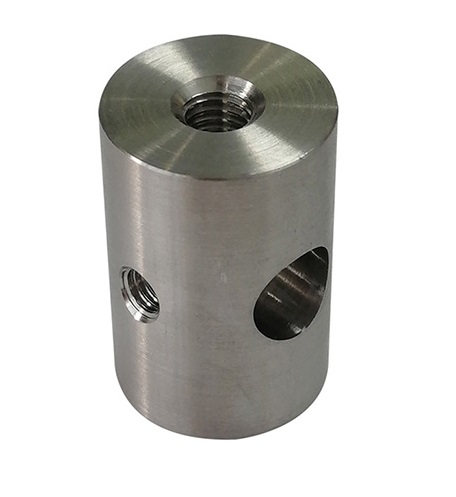Variations of Stainless Steel Standoffs
2024-05-29
Stainless steel standoffs are hardware components used to create a space or distance between two objects, typically for mounting purposes. They are commonly used in architectural, signage, display, and electronic applications to securely attach panels, signs, artwork, and other objects to walls, ceilings, or other surfaces while providing a visually appealing floating effect. Here's an overview of stainless steel standoffs, including their features, variations, and applications:
Features of Stainless Steel Standoffs
1. Material: Stainless steel standoffs are made from high-quality stainless steel, offering durability, corrosion resistance, and a sleek appearance suitable for indoor and outdoor use.
2. Construction: They typically consist of a cylindrical body with threaded ends, allowing for easy installation and secure attachment of objects.
3. Threaded Design: Stainless steel standoffs feature male and female threaded components that screw together to create a stable connection between the mounting surface and the object being installed.
4. Variety of Sizes: Stainless steel standoffs come in various sizes, including different lengths and diameters, to accommodate different mounting requirements and load capacities.
5. Finish Options: They are available in a range of finishes, including polished, brushed, satin, or matte finishes, to complement the aesthetics of the installed objects and surrounding environment.
6. Head Styles: Standoffs may feature different head styles, such as flat, domed, or countersunk heads, depending on the desired appearance and application requirements.
7. Load Capacity: Stainless steel standoffs are designed to support varying loads, ranging from lightweight panels and signs to heavier objects, depending on the size, material thickness, and mounting configuration.
Variations of Stainless Steel Standoffs
1. Standard Standoffs: Standard stainless steel standoffs feature a uniform cylindrical body with threaded ends and are suitable for general mounting applications.
2. Edge-Grip Standoffs: Edge-grip standoffs feature a unique design with gripping fins or jaws that clamp onto the edges of panels or signs, eliminating the need for pre-drilled holes and providing a clean, minimalist mounting solution.
3. Adjustable Standoffs: Adjustable stainless steel standoffs feature a telescoping or adjustable length design, allowing for precise positioning and leveling of mounted objects on uneven surfaces or substrates.
4. Lighted Standoffs: Lighted standoffs incorporate built-in LED lighting elements to illuminate mounted objects, adding visibility and visual appeal to signage, artwork, or displays.
5. Tamper-Resistant Standoffs: Tamper-resistant stainless steel standoffs feature specialized security features, such as tamper-proof screws or locking mechanisms, to deter unauthorized removal or tampering of mounted objects.
Applications of Stainless Steel Standoffs
1. Architectural Signage: Stainless steel standoffs are commonly used in architectural signage applications to mount exterior and interior signs, plaques, directories, and wayfinding systems to walls, doors, and other surfaces.
2. Artwork and Display Mounting: They are used in galleries, museums, exhibitions, and retail environments to securely mount artwork, photographs, posters, and display panels without visible mounting hardware, creating a clean and professional presentation.
3. Glass and Panel Mounting: Stainless steel standoffs are used to mount glass panels, acrylic sheets, mirrors, and decorative panels in architectural and interior design applications, providing a sleek and modern aesthetic.
4. Electronics Enclosures: They are used in electronic enclosures and equipment mounting applications to secure control panels, displays, and electronic components to walls, cabinets, and enclosures, allowing for easy access and maintenance.
5. Furniture and Fixture Mounting: Stainless steel standoffs are utilized in furniture assembly and fixture mounting applications to attach shelves, brackets, and decorative elements to walls and other surfaces, adding functionality and visual interest to interior spaces.
Installation Considerations
1. Surface Preparation: Ensure that the mounting surface is clean, flat, and free of debris before installing stainless steel standoffs to ensure proper adhesion and stability.
2. Drilling and Anchoring: Depending on the mounting surface, drilling may be required to create pilot holes for the standoffs. In some cases, anchors or wall plugs may be necessary to provide additional support and stability.
3. Alignment and Leveling: Take care to align and level the standoffs accurately during installation to ensure that the mounted object is positioned correctly and securely.
4. Torque Control: When tightening the standoffs, use caution to avoid over-tightening, which may damage the mounting surface or compromise the integrity of the installation. Follow manufacturer recommendations for torque specifications to achieve optimal results.
Conclusion
Stainless steel standoffs are versatile hardware components used for mounting and displaying objects in architectural, signage, display, and electronic applications. With their durable construction, corrosion resistance, and sleek appearance, they provide a secure and aesthetically pleasing mounting solution for a wide range of indoor and outdoor environments. When selecting stainless steel standoffs, consider factors such as size, load capacity, finish options, and installation requirements to ensure compatibility with the specific application and mounting surface. Proper installation and alignment are essential to achieve optimal results and ensure the stability and longevity of the mounted objects.



